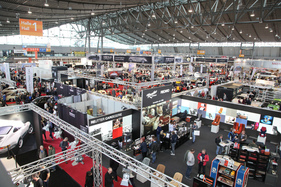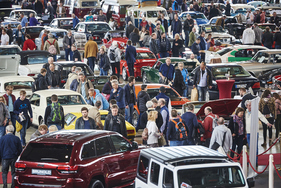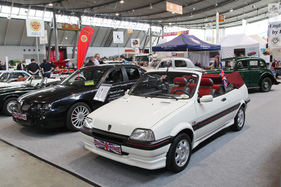140,000 square meters, over 90,000 visitors, around 4,000 cars - these are figures that imply real size. In fact, Retro Classics Stuttgart has nothing to hide from any other classic car fair. It has come a long way since it laid its foundations 18 years ago.

The 19th edition welcomed enthusiasts and collectors of classic vehicles from March 7 to 10, 2019 in nine exhibition halls plus outdoor area and entrance areas in sometimes stormy weather conditions.
No central special show
In contrast to previous years, the organizers decided not to hold a central special show, perhaps also to increase the anticipation for 2020. This is when Gulf racing cars from five decades will be on display at the 20th Retro Classics in Stuttgart. The selection and quantity have not yet been finalized, but you can look forward to Porsche 917, Ford GT40 and Mirage M1, which collector Roald Goethe will bring to the Neckar.
The BMW show
The Herrmanns skillfully kicked the special show ball on to individual exhibitors, who went to great lengths to present their brand in an attractive way.
The BMW Classic representatives from the south did this particularly impressively. In Hall 4, now known as the "BMW Hall", they displayed racing cars from seven decades, starting with the BMW 328 variants and ending with the Williams with a BMW engine from the year 2000.
Of course, the V12 LMR, with which BMW won the 24 Hours of Le Mans in 1999, was not missing. But Formula 1 and 2 monoposti were also on show.
The first Porsche 917
Nevertheless, Porsche almost stole the show from the Bavarians. The restoration of the first Porsche 917 built was completed at the last minute.
Exactly this car with chassis number 001 was presented on March 10, 1969 at the Geneva Motor Show, where a Gulf-Porsche 917 impressed the audience in 2019.
Porsche didn't stop at just one 917, however; to mark the 50th anniversary of this car, a second example from 1972 was placed next to it, namely a 917/10 CanAM car without bodywork.
And if that wasn't enough, the famous 910/8 Bergspyder, which won the European Hill Climb Championship in 1967 and 1968, was also on display.
The car was a prime example of lightweight construction. By using exotic materials, the weight was reduced to just 440 kg.
In contrast to other Porsche museum vehicles, this car was not made drivable again, but was preserved according to every trick in the book so as not to lose any of its original substance.
It's all about business
More than other trade fairs, Retro Classics focuses on business, i.e. sales. Instead of marketing presentations, most exhibitors focus on a selection of cars that visitors can actually buy. Accordingly, there was no line-up of Lancia Stratos or Lamborghini Miura cars in Stuttgart, but hordes of stars and Zuffenhausen boxer engine cars looking for new owners.

Of the 4000 or so cars on display in the halls and outside, around 1700 came from private and commercial sales. Pure exhibits were in the minority.
From the Arna to the VW Beetle, interested visitors found a truly huge selection, if their feet carried them far enough to encompass the entire range.
Of course, it was also a great way to compare prices, and of course it also helped to negotiate if you could find the same vehicle a few hundred meters away. Sometimes, however, two cars were parked right next to each other.
Trouvailles
Among the many classics, most of which are well known, there were also some where you had to read or ask twice to understand exactly what you were looking at.
The SMZ from 1960, for example, was probably just as unknown to most classic car enthusiasts as the Rovin D4 small car.
Former bread and butter cars such as the Opel Olympia or the Lloyd Alexander could also be found in the huge range, as of course could the Beetle and the Volkswagen bus.
Clubs ensure diversification
If private and dealer sales are threatened by a certain monotony due to many similar vehicles, the clubs step into the breach at trade fairs, showing all those cars that hardly play a role in the sales market.

This was once again the case in Stuttgart, where visitors were able to view magnificent installations and stagings of historic automobiles.
And there were real rarities to admire that you don't find every day, such as a Rover 114 Cabriolet, a Mini-based camper van or an Opel Manta B CC GT/E as an emergency ambulance.
Forgotten jubilees?
Of course, the jubilees were not missing from the various stands, even those who are not in the press every day.
For example, there was a reminder that 40 years have passed since the VW Passat GLI was presented, which was only built for two years.
The MG TD is now 70 years old, it was a very popular British roadster back then and its fans remain loyal to it to this day.
The Triumph TR6 will be just as 50 years old this year as the Ford Capri, the VW Porsche 914 and the aforementioned Porsche 917.
And Lotus, by the way, will be 70 years old in 2019 and is still considered a diamond in the rough.
Younger and younger?
For some time now, young cars have also been appearing at Retro Classics trade fairs. They are referred to as Neo Classics, meaning vehicles that are less than 20 years old and have what it takes to become a classic of the future or an instant classic.
Good examples include the BMW Z8, which could of course also be admired in Stuttgart, as well as rare editions of Porsche sports cars, which are often referred to as GT2 or GT3. And, of course, the hot-blooded sports cars from Maranello, Modena and Sant'Agata also belong to this category.

Although Hall 5 was thematically dedicated to neoclassics, many dealers also had young classics from a wide range of manufacturers on display, such as the Alfa Romeo 8C Competizione and modern American muscle cars.
The reaction of the public is mixed, some like it, others find it (a little) annoying. But with around 4,000 cars, everyone still finds interesting vehicles, even if some don't appeal to them at all.
Tricycles and other vehicles
Stuttgart not only demonstrated vehicles on four wheels, two-wheelers and three-wheelers also made an appearance. The AMSC put together a special show with sidecars for sport and road use in Hall 8, and there was a BMW motorcycle show to enjoy in Hall 4.

And of course there were also motorcycles from the Italian brand MV Agusta.
There were also a number of buses and commercial vehicles in a wide variety of designs on display.
What else stood out
Of course, there is not enough space here to list everything that was worth seeing in Stuttgart. But we would like to make two exceptions.
On the Lotus dealer stand in the East entrance area was a Europa Group 4 that Harald Ertl had built in 1979 on the basis of a sports car. 400 hp and a short wheelbase made the car very lively, as Mario Ketterer, who drove the car a few times at the time, told us.
And at the Mazda Musuems stand, there was a 1969 Porter Cab to discover, a so-called kei car, which enjoyed tax privileges in Japan at the time, but was practically non-existent in this country.
Busy weekend
While the number of visitors on Thursday and Friday was not yet excessive, hordes of enthusiasts and interested visitors streamed through the halls at the weekend.
According to Andreas Herrmann, all records were broken on Saturday and Sunday also went really well, which may have had something to do with the end of the vacation in Baden-Württemberg.



























































































































































































































































































































